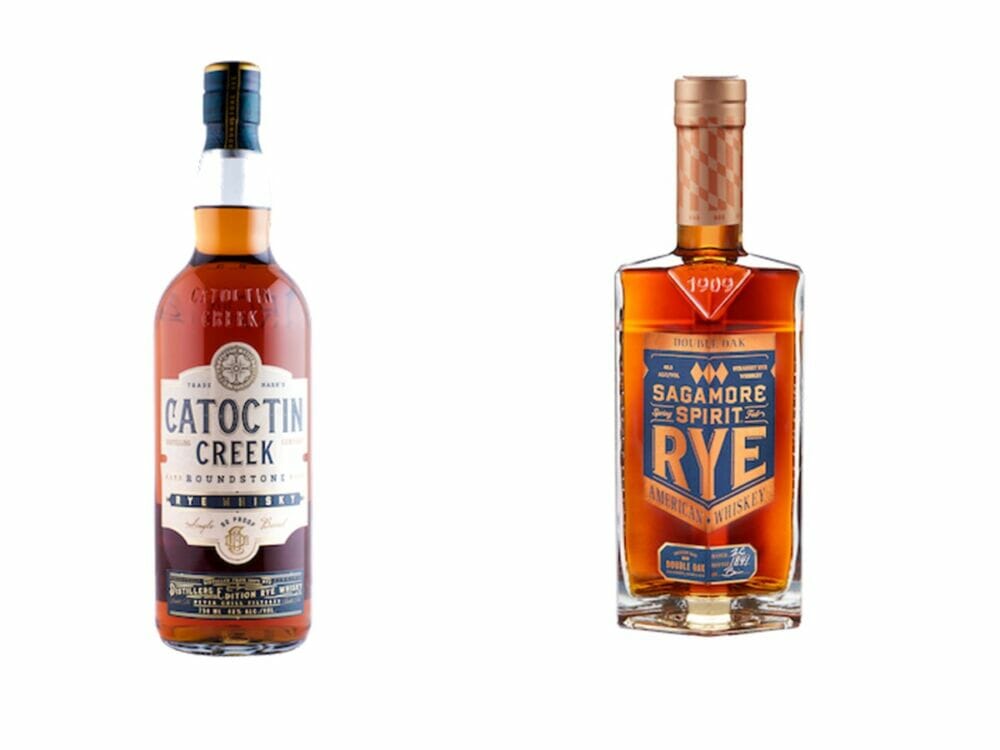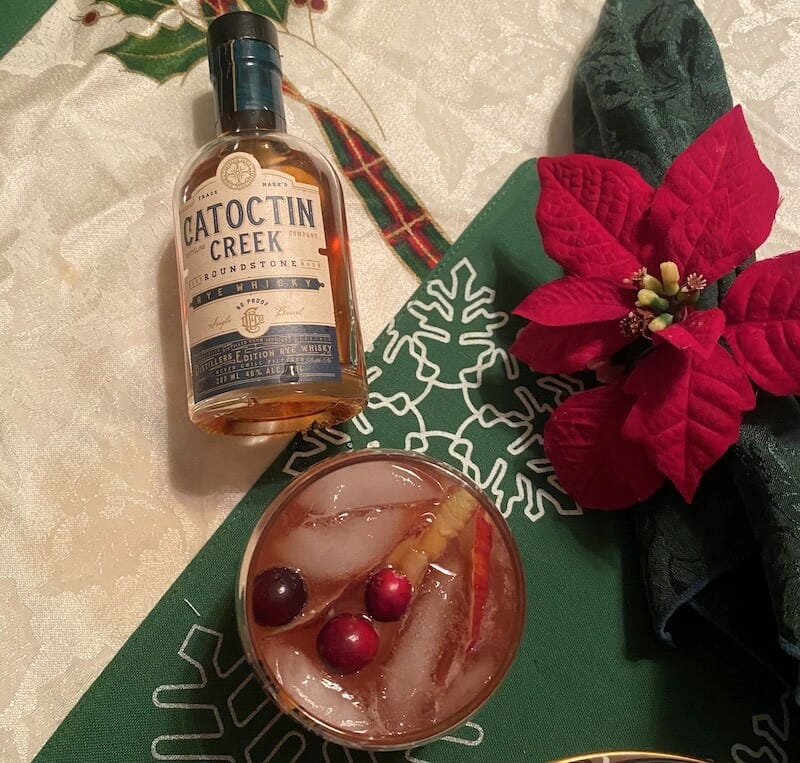
Catoctin Creek – Roundstone Rye Whiskey – 92 Proof
For the “Distiller’s Edition” of Catoctin Creek’s Roundstone Rye only one in every ten barrels gets selected. Head Distiller Becky Harris selects the more interesting barrels from the back of the barrel warehouse that exhibit spicy and deeper flavour notes, and decided to release these at a higher proof: a whisky specially curated for flavour, while still being remarkably smooth
“This single-barrel rye is suitable for sipping or a dessert pairing. Look for bold sugar-cookie aromas and confectionary richness on the palate: vanilla, cocoa, hazelnut, maple sugar and mocha. The moderately long finish is marked by lemon peel and nutmeg.”
– Kara Newman, Wine Enthusiast, January 2020
The History of Rye, by Scott Harris
When colonists came to America, the first permanent British settlement was Jamestown, Virginia in 1607. Immediately, during that time, colonists started making whisky from local grain, most famously (but not exclusively) by George Thorpe.
The style of distillation at this time was necessarily small scale… small home-sized pot stills using local grain and family recipes. Today, we would call this “craft” but back then, it was just one of the necessary items on the family homestead or farm. Ref: Every Home a Distillery So the whisky of that time, predominantly made from rye – the local grain – was influenced by region, terroir and local practices. Ref: The Practical Distiller (1804) by Samuel McHarry. As a town-person, you could take your horse to a local farm and buy jars of whisky. This was common across the state on the small farm and home scale in the 1700s. That is why we refer to Virginia as the birthplace of American whiskey (well before the dawn of bourbon). In fact, when people started distilling corn into bourbon in what is today Kentucky, that land was part of Virginia! Kentucky didn’t become a state until 1792. So, we are cheeky to say it, but Virginia is also the birthplace of Bourbon! Elijah Craig was born and raised in Virginia.
Before the revolutionary war, the most common spirit consumed in the colonies was RUM. This was due to the high levels of trade between Great Britain, the Caribbean, and the colonies. (Sadly, enslaved people being part of this trade along with rum.) Everyone drank rum, and lots of it. But when the colonies rebelled against Great Britain, and won the revolution, King George III cut off his supply of sugar and rum from the Caribbean. No more rum. This led to a huge, and industrial-sized growth in the next ten years of rye whiskey. In places like Maryland and Pennsylvania, rye whiskey became big factory productions, and became the dominant spirit of the mid-Atlantic region, including Virginia. After the revolution, General George Washington, now retired from the presidency, established a distillery on his farm at Mount Vernon in Virginia, not far from Washington DC. Washington had been, ironically, responsible for quelling the whisky rebellion in western Pennsylvania, a rebellion caused by the new national government establishing a new liquor excise tax to pay for the debt caused by the revolutionary war. The rebellion was quelled, but Washington now had the distilling bug in his blood. He would found the largest commercial distillery during his lifetime, producing predominantly rye whisky.
As we passed into the 1800’s, the cocktail was invented (1804 is the first documented recipe for a “whisky cocktail”, later called the “old fashioned whisky cocktail” and later still, called simply the “old fashioned.”). The 1800’s saw a huge boom in cocktails and whisky consumption, dominated mostly by the elite bartenders in New York City – and again, the key whiskey ingredient in those Manhattans, Old Fashioneds, etc. was RYE whiskey, not bourbon. Rye was king on the east coast all the way until Prohibition.
And then Prohibition wiped it all out. 1920-1933 is a long time for industry to survive a total and complete ban on its existence. Before Prohibition, there were over 30 large factory distilleries in Pennsylvania alone. After Prohibition, there were none. And none until the first ones established around 2009! 76 years of nothing.
Until 2009, until Catoctin Creek Distillery.

Catoctin Creek’s Recommended January Cocktail: Johnny’s Snow Day Punch
Ingredients:
45ml Catoctin Creek Distiller’s Edition 92 Proof Roundstone Rye
90ml Apple Cider
15ml Freshly Squeezed Lemon Juice
1 tbsp Cranberry Maple Syrup*
2 dashes Black Walnut Bitters
2 dashes Cranberry Bitters
Half Moon slice of apple & lemon, 3 fresh cranberries and a candied ginger slice
Instructions:
Build all ingredients except ginger beer in a cocktail shaker, shake and strain over ice then top with ginger beer, garnish & serve.
Serve in a Collins Glass or Short Highball with a straw.
Top with Ginger Beer of choice.
Garnish with Fresh Apples, Cranberries, Lemons and Ginger Slices.
Sagamore Spirit – Double Oak Rye
The secret to this Double Oak Rye Whiskey from Sagamore Spirit is 18-months of extended aging time in toasted wave stave barrels, making this whiskey at least seven-years-old. Delightful notes of caramel, honey, hazelnut, and pecan explode on the palate.
History of Sagamore Spirit
Before Prohibition, Maryland was home to 44 distilleries, with 22 in downtown Baltimore alone. Rye was used as a cover crop on tobacco fields, but instead of tilling the rye into the ground at the end of the season, farmers distilled it. After Prohibition, Maryland held one-third of the nation’s rye whiskey supply and Pure Baltimore Rye was synonymous with quality and class.
The Sagamore Spirit Distillery, located in the Port Covington neighborhood of Baltimore, is consistently ranked as one of the top distilleries in the nation. The five-acre waterfront campus features a 40-foot mirrored-finished copper column still, nine fermentation tanks, and a contemporary cocktail bar. The distillery is open five days a week for tours and tastings.

Sagamore Spirit’s Recommended Cocktail: Sagamore Winter Mule
Ingredients:
45 ml Sagamore Spirit Signature Rye Whiskey
30ml Cranberry Juice
10ml Lemon Juice
10 ml Organic Maple Syrup
60 ml Ginger Beer.
Sage Leaf, Optional
Instructions:
Fill a Collins glass with ice.
Add Sagamore Spirit Signature Rye Whiskey, cranberry juice, lemon juice and maple syrup.
Top with ginger beer and give a slight stir to combine.
Garnish with a sage leaf.
About Rye January
The dedication of the month was announced by Catoctin Creek for the first time last year when they invited those not taking part in Dry January to join them in celebration of Rye Whisky.
Classic Manhattan Cocktail Recipe from Scott Harris of Catoctin Creek
The use of the Carpano vermouth makes this cocktail. The vermouth itself is totally drinkable alone: I taste figs, dates, licorice, and delicious raisins. But when added to the Manhattan, the vermouth adds a wonderful herb aroma to the sweetness of the rye.
60 ml Catoctin Creek Roundstone Rye
30 ml Carpano Anitca sweet red Italian vermouth (The absolute best!)
1 dash bitters (Peychauds or your favorite)
1 tsp cherry juice
Brandied cherry for garnish
Pour into a mixing glass with crushed ice, stir, strain into a cocktail glass, garnish with a Maraschino cherry.
